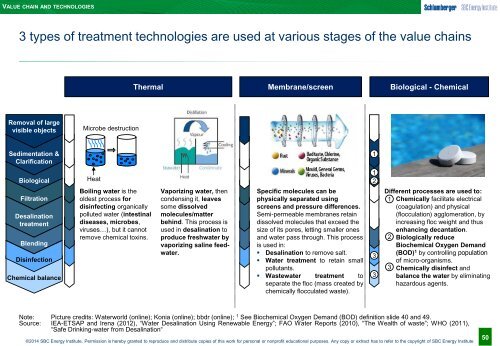1wMF53w
1wMF53w
1wMF53w
Create successful ePaper yourself
Turn your PDF publications into a flip-book with our unique Google optimized e-Paper software.
VALUE CHAIN AND TECHNOLOGIES<br />
3 types of treatment technologies are used at various stages of the value chains<br />
Thermal<br />
Membrane/screen<br />
Biological - Chemical<br />
Removal of large<br />
visible objects<br />
Microbe destruction<br />
Sedimentation &<br />
Clarification<br />
1<br />
Biological<br />
Heat<br />
1<br />
2<br />
Filtration<br />
Desalination<br />
treatment<br />
Blending<br />
Disinfection<br />
Chemical balance<br />
Boiling water is the<br />
oldest process for<br />
disinfecting organically<br />
polluted water (intestinal<br />
diseases, microbes,<br />
viruses…), but it cannot<br />
remove chemical toxins.<br />
Vaporizing water, then<br />
condensing it, leaves<br />
some dissolved<br />
molecules/matter<br />
behind. This process is<br />
used in desalination to<br />
produce freshwater by<br />
vaporizing saline feedwater.<br />
Specific molecules can be<br />
physically separated using<br />
screens and pressure differences.<br />
Semi-permeable membranes retain<br />
dissolved molecules that exceed the<br />
size of its pores, letting smaller ones<br />
and water pass through. This process<br />
is used in:<br />
• Desalination to remove salt.<br />
• Water treatment to retain small<br />
pollutants.<br />
• Wastewater treatment to<br />
separate the floc (mass created by<br />
chemically flocculated waste).<br />
3<br />
3<br />
Different processes are used to:<br />
• 1 Chemically facilitate electrical<br />
(coagulation) and physical<br />
(flocculation) agglomeration, by<br />
increasing floc weight and thus<br />
enhancing decantation.<br />
• 2 Biologically reduce<br />
Biochemical Oxygen Demand<br />
(BOD) 1 by controlling population<br />
of micro-organisms.<br />
• 3 Chemically disinfect and<br />
balance the water by eliminating<br />
hazardous agents.<br />
Note: Picture credits: Waterworld (online); Konia (online); bbdr (online); 1 See Biochemical Oxygen Demand (BOD) definition slide 40 and 49.<br />
Source: IEA-ETSAP and Irena (2012), “Water Desalination Using Renewable Energy”; FAO Water Reports (2010), “The Wealth of waste”; WHO (2011),<br />
“Safe Drinking-water from Desalination“<br />
50<br />
©2014 SBC Energy Institute. Permission is hereby granted to reproduce and distribute copies of this work for personal or nonprofit educational purposes. Any copy or extract has to refer to the copyright of SBC Energy Institute<br />
50


